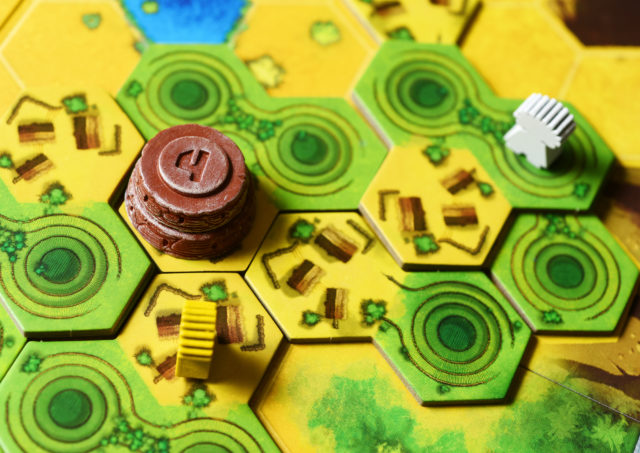Cuzco used to be Java. You savvy? No? Well, lean in Jimbo me boy, and I’ll tell ya a tale…
Back in the day (by which I mean the turn of the millennium) two German blokes by the name of Kiesling and Kramer teamed up to design a trilogy of games that used a system whereby players had a large menu of choices for things they could do on their turn, each of which was more or less expensive, time-wise. And since time is finite, the challenge was figuring out the optimal mix of actions each turn.

They called it the Action Point (or AP) system. Some of you might notice those initials stand for something else–Analysis Paralysis–and indeed one AP often leads to another. Nonetheless, the three games, Tikal (1999), Java (2000), and Mexica (2002), all released by Ravensburger, went on to become pretty big sellers. Since each box was dominated by the picture of a relevant culturally-appropriate(d) mask, the games are also called the Mask Trilogy.
As the art of game design moved on, AP (and its attendant AP) fell out of favour as designers figured out other ways for players to make choices in more interactive ways (worker placement, for example). But interest in the Mask Trilogy games remained high enough, even though out of print, that publishers began re-releasing them in smaller boxes with better components. Mexica reappeared in 2015, and now Java is seeing the light of day. It makes sense that they decided to move the action to Peru, because then all three games would have Mesoamerican themes.

I owned Java back in the day and enjoyed it. It also looked pretty good, with an earthy tone palette and thick terrain tiles which gave the game its crucial third dimension. You see, in Java/Cuzco players start the game staring at a mainly-blank board; on their turns the first thing players must do is add a terrain tile (which costs one of their six available Action Points). The tiles are a mixture of empty fields and villages. The goal is to set up large villages upon which large temples can be built, turning them into cities (and getting VP according to the size of the temple). You can also surround ponds for surprisingly-high amounts of VP.
However, only the player at the highest elevation in each village or city or adjacent to the just-completed pond, can score, so layer after layer of terrain gets added on as the turns go by. You can (and should) pooch someone else’s temple by moving one of your own guys in, making sure to do some creative landscaping first.

There’s also a festival-throwing sub-mechanic involving cardplay from a deck of relics…it doesn’t really feel like it belongs in the game, but I guess K & K decided the game needed some way to introduce some interactivity and a way for players who could never quite manage to dominate the landscape to still get some points during the game. It just feels artificially bolted on.
The majority of points come from endgame scoring. Cuzco has an unusual endgame in that once it is triggered by the final neutral terrain piece being played, each player (including the triggerer) gets one final turn to go all out and is then scored for every temple in the game. What’s nice about it is that it’s hard (and usually sub-optimal) to screw someone else over on that final turn: you’re better off just grabbing as many points as possible for yourself. It does depend on player-count and seating order, however, as with four it might be worth it making it impossible for someone later in the order to score altogether even if it means you only get half points. With two it’s definitely not worth it, as only the top two players at each temple score.
As much as I liked the look of Java, I must say Cuzco looks even better through and through. The box art is less menacing, and its size and proportion are more Kallax-friendly. The colour palette and design for the terrain pieces is brighter, and the temple pieces in particular are fantastic looking, made out of resin or something that gives them a faux-stone look.

The one thing that Cuzco does not solve is the AP problem, and I mean that in both senses. The rules are (based on my ever-more-cheesecloth memory) exactly the same, which means that unless your group is brisk-paced you could be facing a fair amount of downtime between turns, especially near the end of the game. My solution with Java used to be to use a timer, and give players 5 minutes per move; in practice no one ever took more than 2.
It’s great that these older designs are getting some visibility; I’d be curious to know how people who had never played Java felt about Cuzco in the context of today’s design space. What do you think?
Thanks to the folks at Super Meeple and Luma Imports for providing a copy of Cuzco for this review.
Comments
No comments yet! Be the first!